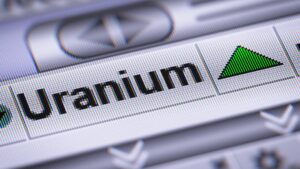Rick Rule says uranium stocks frothy, less attractive than last bull market

Pic: Bloomberg Creative / Bloomberg Creative Photos via Getty Images
Monday was wild for ASX uranium stocks, with 21 ending the day on double digit percentage gains.
Uranium investor sentiment is sky high. Every #ASX stock on our list, except one, is making gains in morning trade Monday.
At least 20 of them are in double digits.$ERA $DLC $DYL $ACB $92E $EME $VMY $VAL $AGE
— Stockhead (@StockheadAU) September 13, 2021
The ASX uranium frenzy took a slight breather Tuesday, even as spot prices leapt another $US2/lb to +$US44/lb overnight.
That’s a nine-year high.
We are rapidly closing in on $US60/lb – the magic number many of the next crop of producers need to be viable.
Legendary investor and Sprott director and shareholder Rick Rule is bullish on uranium.
Uranium stocks? Not so much, especially in the short term.
In a September 1 interview – prior to the latest share price explosion – Rule says he timed the market badly.
“I got the uranium equity market exactly wrong,” he told BABY Investments.
“I had expected the market to be flat. Instead, because of speculative fervour, the junior uranium market exploded upwards.
“I reduced a lot of my positions by 50%, 60%. I didn’t exit the sector entirely, but if there’s not much to buy, it’s probably time to sell.”
This was before the Sprott Physical Uranium Trust (SPUT) — which started buying up physical uranium and taking it out of market circulation in August – really began to pick up steam.
Uranium stocks less attractive than 2007
During the last uranium bull run in 2007, Rule bought Paladin Energy (ASX:PDN) at 10c. It went down to 1c … then all the way to ~$10 a share.
“I’m less attracted to the uranium market this cycle than I was last cycle because the market caps are too high,” he says.
“When I talk to you about the fun I had with [investing in] Paladin — going from 10c to $10 per share — one of the things people forget is the fact that the starting market cap was $1.7m.
“It’s much easier to get a 10,000 bagger if you start with a sub $2m market cap, than if you start with a $200m market cap.”
When you look across the market capitalisation of the so-called juniors today the starting point isn’t cheap, Rule says.
“I talk to an audience about the fact that a collection of the 10 best junior uranium stocks could triple in a five-year time frame, and people act like I am traitorous,” he says
“‘Oh no, it is a minimum of 10 or 15 times!’, they say.
“10 or 15 times starting with a half a billion-market cap means they are suggesting that some of these little companies will have market caps that exceed [world’s largest publicly traded uranium company] Cameco’s [$US9.73bn market cap].
“I find that unlikely.”
Too many people in the narrative now are expecting 10-baggers. Rule believes 300% returns are more probable.
“When I run net present value calculations on some decent companies at $US60/lb or $US70/lb yellowcake I see probable triples,” he says.
“I personally believe a three-bagger over five years, something like 35% compounded internal rate of return – especially considering that it’s a probability, not a possibility – is a good thing.
“I’m looking to allocate a bit of my own money and a bigger bit of client money, and I’m looking to get 35% to 40% compounded internal returns over three to five years.
“That seems pretty good to me.”
UNLOCK INSIGHTS
Discover the untold stories of emerging ASX stocks.
Daily news and expert analysis, it's free to subscribe.
By proceeding, you confirm you understand that we handle personal information in accordance with our Privacy Policy.








